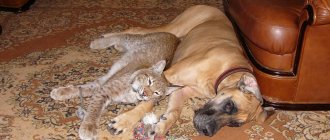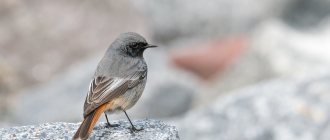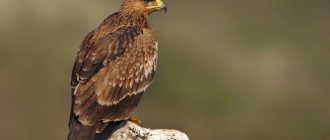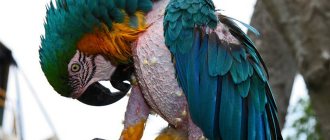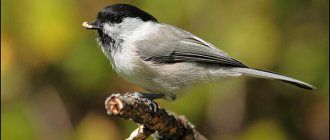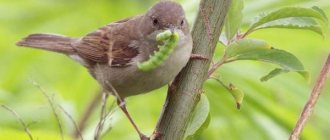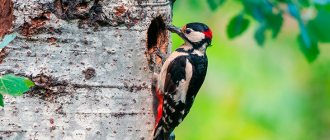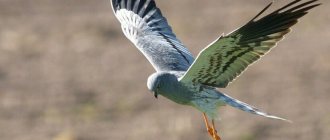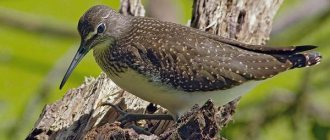In ancient times in Rus' there was a legend about a young woman who lost her husband. The inconsolable widow turned into a lapwing bird and to this day flies into the sky and cries loudly about her grief.
The lapwing is a bird that lives in many parts of our country. In Russia it is called differently: meadow, and also pigalitsa. The ancient Slavs considered this bird sacred; people did not touch its nest. They did not kill the bird itself. The lapwing is a noticeable bird, it has wonderful plumage, look at the photo of the lapwing and see for yourself. Scientists attribute this bird to the order Charadriiformes, the family Charadriiformes, and the genus Lapwings.
Lapwing (Vanellus vanellus).
What does a chibi bird look like?
Pigalitsa have a dark green back with a metallic sheen, black coloring on the head and neck, and a characteristic crest of black or gray color, the ends of which are curled up. The bird's chest is black, its belly and sides are white, and its tail is red. In appearance, the pigtail resembles an ordinary jackdaw.
Photo of lapwing bird
The bird's wings are 21-24 cm long and can span up to 85 cm. The weight of the female and male can reach 300 grams with a body length of 28-34 cm. The lapwing has a distinctive feature that distinguishes it from other birds - it changes plumage depending on the time of year . In winter, the neck and crop are almost white, and in summer they are black.
The singing of the Pigalitsa during the calm period is very melodic and calm. But not everyone likes a loud and alarming cry. In moments of danger, to warn others about the enemy, the sound of the bird resembles the cry “Whose are you, whose are you.” Some argue that the name of the bird came precisely from its cry.
According to one of the legends of Ancient Rus', lapwings were considered sacred birds. The sound of crying, sadness and grief was compared with the voice of a mother grieving for her children or losing them. Singing was also considered a wagon of grief for widows.
Great grebe
This waterfowl is very loved by illustrators of children's books, and all because of the original tufts of feathers on its head, forming 2 fluffy crests. It is interesting that birds only have this decoration in their spring plumage. The same goes for the red “collar” around the neck.
In the literature, the great grebe is more often found under the name grebe. It is slightly smaller in size than a duck. She has a thin flexible neck, a long beak and leathery membranes on her feet - everything necessary for an aquatic lifestyle.
Great grebes live in stagnant bodies of water throughout Eurasia, with the exception of the extreme northern regions, and are found in Australia and New Zealand, as well as in some areas of Africa.
Differences between females and males
The main difference between individuals of different sexes is color. During the mating season, the male's plumage changes noticeably - it becomes brighter, making him more noticeable. The crest feathers become green, the head takes on a greenish emerald hue, and the neck and sides of the head become white. The tail feathers are white with a characteristic black line at the very tip. The female's crest feathers are smaller than those of her partner, and the metallic sheen is not so noticeable.
The length of the wings of a female individual is 20.5-24 cm, tail - 10-11 cm, tarsus - 5.5 cm. Males are much larger: wing length - 22-24 cm, tail - 9-11 cm, tarsus - 4, 5-5 cm.
Pigalitsa on the lake
Crowned pigeons
Birds of extraordinary beauty, whose heads are crowned not just with crests, but with real crowns.
The genus of crowned pigeons includes 3 species, and all of them live only on the island of Papua New Guinea:
- crowned pigeon;
- chestnut-breasted crowned pigeon;
- fan crowned pigeon.
Interestingly, males and females look exactly the same. However, they differ from pigeons in the usual sense not only in their crest and unusual plumage color, but also in size. The height of crowned pigeons reaches 80 cm, and they weigh about 2.5 kg.
The local population exterminated these birds for tasty meat, which led to a sharp decline in the population. Today, crowned pigeons are a vulnerable species and are protected by the state.
Where does the lapwing bird live?
The bird with a crest on its head lives over a fairly vast territory, which occupies the space from the Atlantic Ocean to the Pacific Ocean; they are also spotted around the Baltic Sea. This bird is migratory and flies to India, Japan, China, Asia or the shores of the Mediterranean Sea for the winter.
To migrate to warmer regions, they group in numerous flocks from August and leave their native lands together. In areas with warmer climates, birds may stay until the first frost, and then leave.
They live mainly in damp, damp places. Such places include marshy areas, wet meadows, wet glades, and agricultural fields with an irrigation system.
Pigalites behave confidently in flight. Thanks to their small body size and correspondingly low weight, they maneuver well and can reach fairly high speeds.
Pigalitsa in a pond
Hoopoe
Another species of bird with a similar decoration is the hoopoe.
In size, the bird is almost equal to the waxwing. The hoopoe has a long thin beak up to 4-6 cm. The color is very bright: a reddish back, wings and tail are black with white stripes, a high red crest with a black border, normally folded. Birds are widespread throughout our country - the Central Black Earth region, Siberia, Transbaikalia, and the Far East.
These bird species live in open plain or forest-steppe areas . They can run quickly on the ground, and in case of danger, press down to the ground, spreading their wings and raising their beak up.
The hoopoe can feed on both insects and small reptiles (snakes, etc.). Birds make nests in dense thickets, and protection from enemies is the unpleasant smell that comes from the droppings left on the nesting sites.
A clutch usually contains from 3 to 8 eggs, which incubate for two weeks. Parents continue to care for the chicks after they fly out of the nest.
What does the lapwing bird eat?
Since birds of the genus Charadrii prefer watery, damp areas, their diet is appropriate. They prefer beetles, worms, slugs, wireworm larvae, grasshoppers and grasshoppers in the field, and crayfish and mollusks in the water.
Lapwing looking for food
Thanks to their beak, which is not as large as that of aquatic birds, lapwings can get food from shallow depths or search for it on the surface. Birds are active in the morning, since as the sun rises and the air temperature rises, the beetles hide in the bark of trees and are difficult to find.
Some varieties of lapwings also feed on other insects. For example, the Ornate Lapwing hunts termites, locusts and molluscs at night. The lapwing pampers itself with mosquitoes, spiders, tadpoles and mollusks.
Photo of Pigalitsa
Nutrition
The diet of lapwings, like most waders, includes mainly animal food. Small feathered predators feed on slugs, caterpillars, larvae, butterflies, small snails, and earthworms. Plant foods are rather an exception to the rule. Plant seeds can attract birds.
Birds are unusually active when hunting. You can observe their nimble movement among the grass. Uneven ground, holes, and hummocks do not interfere with their running. There are sudden stops, looking around, assessing what is happening around in order to make sure of safety and identify new hunting targets.
The lapwing bird is useful to agriculture as an insect pest fighter. The destruction of beetles, their larvae, and various invertebrate organisms helps to protect cultivated plants and the future harvest.
Nesting
Since lapwings do not tolerate heat well, they try to hatch the chicks before it sets in.
The first clutches begin in April, but often frosts, high water and a large mass of melt water prevent them from hatching. The pigtails divide into pairs immediately upon arrival, find a place to build a nest, and the male prepares several holes in the ground. Among these nesting holes, the female selects a suitable hole for the nest.
Mating games
The nest is built on the surface of the ground, deepened and lined with grass. The female lays 4 eggs (rarely there can be 3 or 5) in the shape of a cone, olive-brown in color with dark dots. The eggshell is matte and weighs on average 27 grams. The egg size can reach 36 mm in diameter and 46 mm in length. The female incubates the offspring, the opposite individual protects the female and the nest from enemies. Hatching occurs after 25-29 days.
Lapwing nesting
The first time after hatching, the chicks are with their mother and can only crawl out from under her for a while. After 3-4 weeks, babies learn to fly. When the chicks get stronger, the parents move them to a more humid place where there is food.
The color of the chicks and their parents helps to camouflage them from enemies. The main threat comes from jackals, wolves, birds of prey, hunters, and dogs.
Lapwing bird egg
Chibis at home
Pigalitsa is not at all wary of people, since it is a frequent visitor to farmlands; the bird may scream, but does not leave the nest.
Lapwing chicks can be raised at home, but they do very poorly in captivity. If you find an injured bird, it is best to release it after treatment. Do not treat yourself; it is better to consult an ornithologist veterinarian.
While the bird is in your home, do not touch it again, give it peace and quiet to recuperate. Feed frequently with vegetation, insects or grains. You can use specialized food for birds.
Remember, keeping birds without a license is illegal. Lapwings can be kept at home only for rehabilitation, after which they can be released.
Pigalitsa near the river
Lifespan
A healthy lapwing can live 15-20 years. A large number of birds die during migration, which takes a lot of energy. In addition, many birds die in Asian countries from people who consider them a delicacy.
Since the number of birds decreases every year, ornithologists are trying to preserve them. But in France and Spain, sport hunting of birds is still allowed. For Germans, lapwing eggs are a delicacy, and until 2006, they were eaten by highly respected people instead of chicken eggs. Otto von Bismarck, the first Chancellor of the German Empire, was delivered 101 feathered eggs from Lower Saxony for each birthday. As a token of gratitude, on the occasion he gave them a cup, the lid of which was shaped like the head of this bird.
Pigalitsa in profile
Listen to the bird's voice
The audio tag is not supported by your browser. Close

